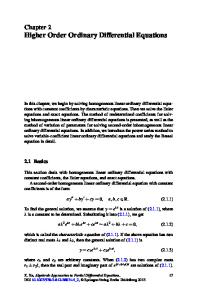Second Order Differential Equations Special Functions and Their Clas
Second Order Differential Equations presents a classical piece of theory concerning hypergeometric special functions as solutions of second-order linear differential equations. The theory is presented in an entirely self-contained way, starting with an in
- PDF / 2,638,308 Bytes
- 225 Pages / 439.37 x 666.142 pts Page_size
- 6 Downloads / 381 Views
Gerhard Kristensson
Second Order Differential Equations Special Functions and Their Classification
Gerhard Kristensson Department of Electrical and Information Technology Lund University SE-221 00 Lund Sweden [email protected]
ISBN 978-1-4419-7019-0 e-ISBN 978-1-4419-7020-6 DOI 10.1007/978-1-4419-7020-6 Springer New York Dordrecht Heidelberg London Library of Congress Control Number: 2010931828 Mathematics Subject Classification (2010): 33XX, 33CXX, 34XX, 34MXX © Springer Science+Business Media, LLC 2010 All rights reserved. This work may not be translated or copied in whole or in part without the written permission of the publisher (Springer Science+Business Media, LLC, 233 Spring Street, New York, NY 10013, USA), except for brief excerpts in connection with reviews or scholarly analysis. Use in connection with any form of information storage and retrieval, electronic adaptation, computer software, or by similar or dissimilar methodology now known or hereafter developed is forbidden. The use in this publication of trade names, trademarks, service marks, and similar terms, even if they are not identified as such, is not to be taken as an expression of opinion as to whether or not they are subject to proprietary rights. Printed on acid-free paper Springer is part of Springer Science+Business Media (www.springer.com)
To the Memory of my Father, Gunnar
Preface
With modern computers and software tools, there are, in general, no problems generating numerical values to various kinds of special functions. Indeed, excellent software, such as Mathematica, Maple, and MATLAB, can generate a large variety of special functions with high precision. Moreover, the general topic of special functions is well covered in the literature, see, e.g., [2, 3, 8, 14, 20, 28]. However, the knowledge of the overall structure and relationship between the different special functions is often lacking nowadays. This textbook tries to remedy that need. The presentation of the theory in the book does not deal with the particular properties of various special functions, but rather focuses on the generic connection between the functions and the families they belong to. The way the special functions are introduced and classified is the subject of the current textbook. The aim is to provide a self-contained treatment of the subject intended for the upper undergraduate, graduate student, or the researcher in mathematical physics who has a need to understand the underlying systematics of special functions. There are many ways of approaching this subject indeed. The most popular ones are: • Classification and systematics based upon the singular behavior of the coefficients of the underlying ordinary differential equation, see, e.g., [12, 23] • Group theoretical approach, see, e.g., [17, 27, 29] • Classification and systematics based upon integral averages, see, e.g., [4] We pursue the first, most traditional, approach in this textbook. The singular behavior of the coefficients manifests itself by the number of singular points — pole
Data Loading...











